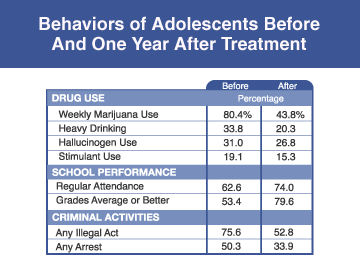In the first large-scale study designed to evaluate drug abuse treatment outcomes among adolescents in age-specific treatment programs, NIDA-supported researchers have found that longer stays in these treatment programs can effectively decrease drug and alcohol use and criminal activity as well as improve school performance and psychological adjustment.
 An evaluation of more than 1,100 adolescents who received substance abuse treatment in residential, short-term inpatient, or drug-free outpatient programs found improvement in rates of drug use and social behavior. Some 53 percent of those treated met or exceeded the minimum recommended stay in treatment.
An evaluation of more than 1,100 adolescents who received substance abuse treatment in residential, short-term inpatient, or drug-free outpatient programs found improvement in rates of drug use and social behavior. Some 53 percent of those treated met or exceeded the minimum recommended stay in treatment.The study, part of NIDA's ongoing Drug Abuse Treatment Outcome Studies for Adolescents (DATOS-A), analyzed data from 23 community-based adolescent treatment programs that addressed peer relationships, educational concerns, and family issues such as parent-child relationships and parental substance abuse. Successful elements of adult treatment programs, such as participation in group therapy and participation in a 12-step program, were also included in treatment plans.
"The results of this study are particularly impressive in light of the fact that the adolescents had multiple problems," says Dr. Christine Grella of the University of California, Los Angeles (UCLA), Drug Abuse Research Center, one of the study's investigators. "Although this is also typical of many adults in treatment, timely resolution of these problems is even more critical for adolescents. These young people are in the process of developing values, making lifestyle decisions, and preparing to assume adult roles and responsibilities, such as family and work; whereas when many adults enter treatment, they have completed this process."
Treatment Programs Varied
Dr. Yih-Ing Hser, also of UCLA, led the research team that evaluated the treatment outcomes for 1,167 adolescents, age 11 to 18, who were admitted to one of the treatment programs between 1993 and 1995. The treatment centers, located in Pittsburgh, Pennsylvania; Minneapolis, Minnesota; Chicago, Illinois; and Portland, Oregon, included eight residential programs, nine outpatient drug-free programs, and six short-term inpatient programs.
The 418 adolescents in the residential treatment programs received education, individual and group counseling, and interventions to develop social responsibility. The 292 adolescents in the outpatient drug-free programs received education, skills training, and individual and group counseling. The 467 adolescents in short-term inpatient programs received counseling and a 12-step program. Family therapy was strongly emphasized, and adolescents in these programs were referred to continued outpatient treatment. The average length of treatment for adolescents in the residential, outpatient drug-free, and short-term inpatient programs was 5 months, 1.6 months, and 18 days, respectively.
The adolescents were interviewed when they began treatment and again 1 year after discharge by professional interviewers who were not employed by the treatment centers. Problem severity was determined at the initial interview according to a number of criteria. Dependence on drugs or alcohol was determined from standardized diagnostic measures. To validate self-reports of drug use, one-quarter of the participants were selected randomly to submit urine samples during the posttreatment interview.
Before treatment, 25 percent of the participants used three or more drugs, 36 percent were dependent on alcohol, 64 percent were dependent on marijuana, and 10 percent were dependent on cocaine. In addition to substance abuse problems, 63 percent were diagnosed with a mental disorder and 67 percent were criminally active.
Outcomes Overall
Research has indicated that in general the rate of drug and alcohol use tends to increase during adolescence. In the present study, however, improvements were observed in many of the areas evaluated, although some of the participants did not complete their treatment program. Comparing the year before treatment to the year after treatment, the adolescents showed significant declines in the use of marijuana and alcohol, which are considered to be the major drugs of abuse for this age group. Weekly or more frequent marijuana use dropped from 80 percent to 44 percent, and abstinence from any use of other illicit drugs increased from 52 percent to 58 percent. Heavy drinking decreased from 34 percent to 20 percent, and criminal activity decreased from 76 percent to 53 percent. Adolescents also reported fewer thoughts of suicide, lower hostility, and higher self-esteem. In the year following treatment, more adolescents attended school and reported average or better-than-average grades. Some exceptions to the general pattern of improvement were that overall, cocaine and hallucinogen use did not improve during the year after treatment.
Treatment Length and Outcomes
Previous research indicates that a minimum of 90 days of treatment for residential and outpatient drug-free programs and 21 days for short-term inpatient programs is predictive of positive outcomes for adults in treatment. Better treatment outcomes were reported among adolescents who met or exceeded these minimum lengths of treatment than for those who did not. Among the treatment participants, 58 percent of those in residential programs, 27 percent in outpatient drug-free programs, and 64 percent in short-term inpatient programs met or exceeded the minimum stay. In the year following treatment, those who met or exceeded the minimum treatment were 1.52 times more likely to abstain from drug and alcohol use and 1.2 times more likely to not be involved in criminal activity. In addition, these adolescents were 1.34 times more likely to have average or better-than-average grades.
This study confirms that community-based drug treatment programs designed for adolescents can reduce substance abuse and have a positive impact on many other aspects of their life, says Dr. Tom Hilton of NIDA's Division of Epidemiology, Services and Prevention Research. These results justify new research to identify the key elements common to effective treatment programs for adolescents, he noted.
Source
- Hser, Y-I.; Grella, C.E.; Hubbard, R.L.; et al. An evaluation of drug treatment for adolescents in four U.S. cities. Archives of General Psychiatry 58(7):689-695, 2001.